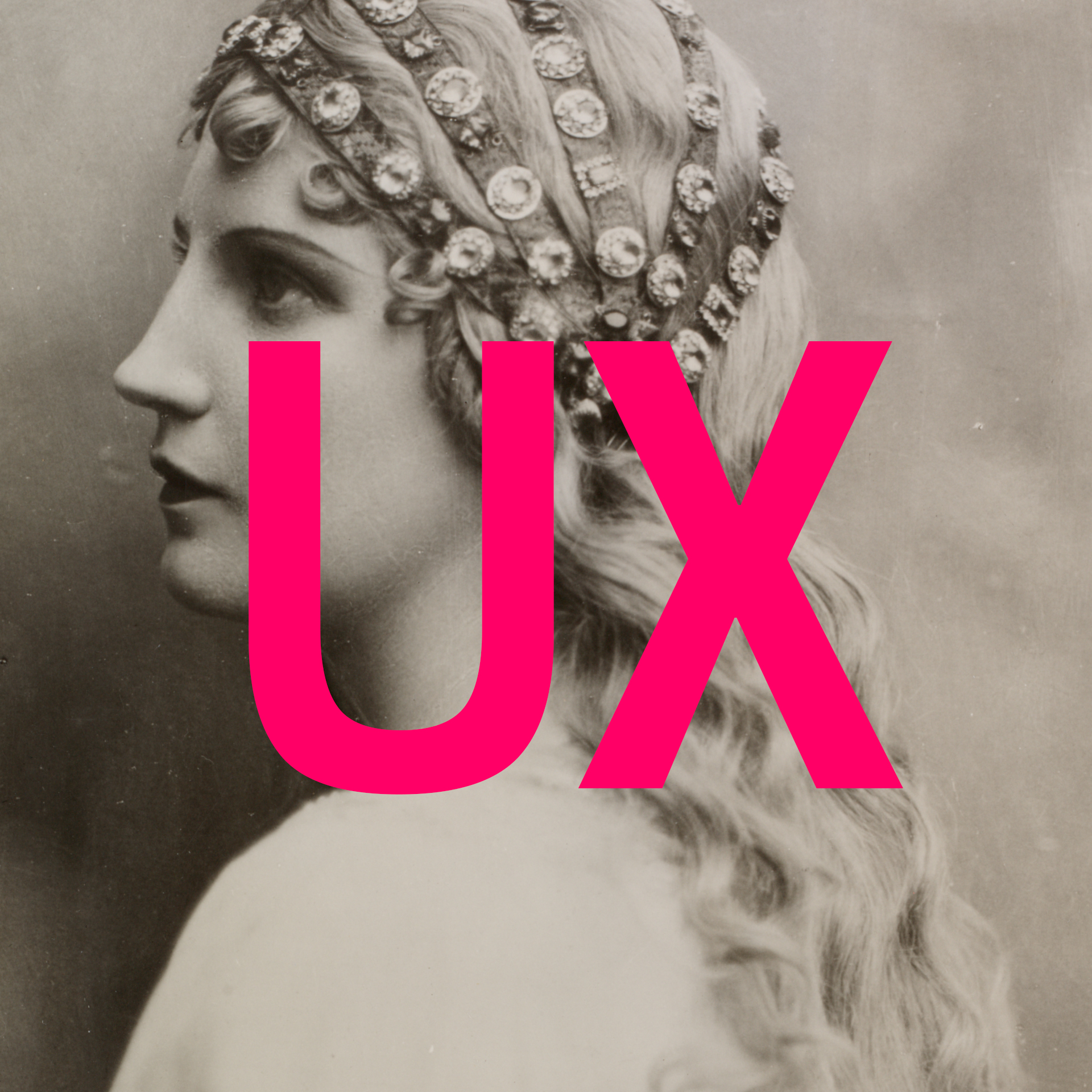
#NewSelfWales ux research + testing
The Library is nearing the end of a major building redevelopment – the transformation of its historic Mitchell Building. Heritage areas never-before open to the public are being turned into beautiful new galleries and informal spaces. The new Michael Crouch Family Galleries will – along with the existing Dixson Galleries – stretch across the entire first floor of the Mitchell, effectively doubling the Library’s exhibition spaces.
As part of the opening suite of exhibitions, the DX Lab is working on delivering experimental digital experiences.
#NewSelfWales is one that invites audiences to upload a photo of themselves via Instagram or via a photo booth in the gallery so that we can ‘collect the face of NSW in 2018’. These portraits will appear in our gallery experience alongside thousands of portraits already in our collection.
The Gallery
The space that this will be located in is at the entry to the galleries from the Mitchell vestibule on the western side. It will be the first experience that visitors have when they arrive from the marble staircase leading up from the vestibule. The space is 88m2 and we have three large walls to project onto using high lumens projectors.
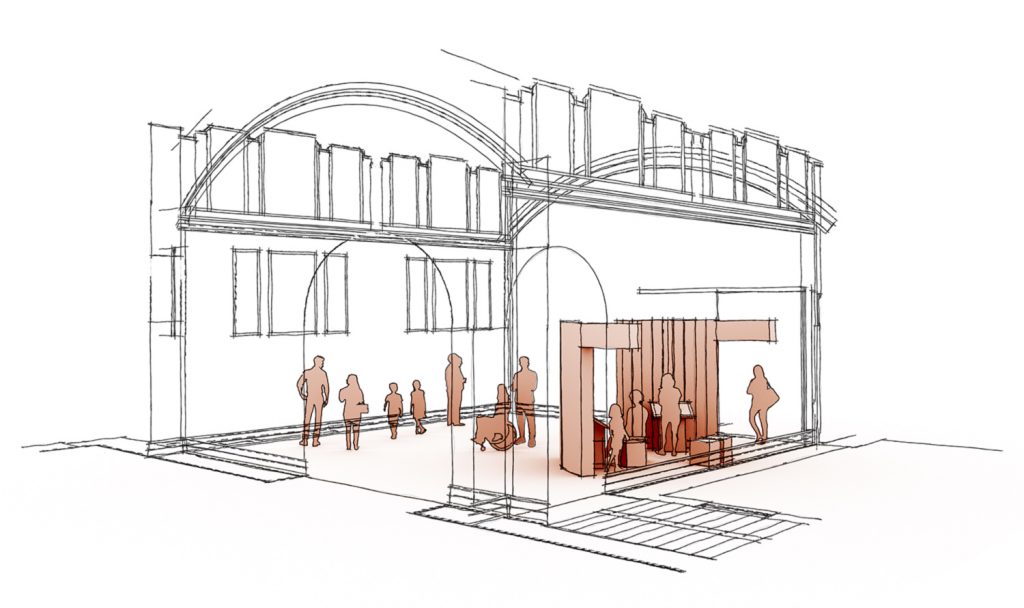
One of the main aims of the DX Lab’s work is to find innovative ways for our readers to discover and interact with the collections, either in the Library or online, and be inspired to use and share them with others. In this gallery installation we will be using thousands of images from the Library’s image collections to display the diverse range of portraits that have been collected over many decades. These portraits will be mixed with contemporary portraits received from the public via a data feed from Instagram and the photo booths in the Library that will be displayed to present the many faces of the collection.
When designing the installation we needed to consider what is being exhibited in the other galleries. The gallery closest to #NewSelfWales will showcase around 300 portraits and landscapes from the collection that will be hung so the visitor will see a mass of collection items at once. The juxtaposition of both digital and physical works displayed in close proximity demonstrates the importance of the Library collecting in all mediums and across time to enable us to document and tell the story of New South Wales
The DX Lab is working with other teams across the Library to deliver this new gallery experience/experiment. We have collaborated with the Research and Discovery curators who have helped us select content and the Exhibitions team, particularly 3D design, who have helped with the physical design and installation.The Media and Communications team has partnered with us on their new campaign which promotes the collection and the Library in a way that we have not done before.
When the DX Lab was first approached to work on this experience our initial thoughts were that we need to make this different to other selfie experiences that you can have in almost any gallery or museum. We were asking ourselves, ‘Why would a Library do this?’ ‘What would be our point of difference?’. As we researched what was going on internationally with ‘selfie’ experiences we found some pretty sophisticated examples such as this one ‘As We Are’ a large interactive LED sculpture by artist Matthew Mohr. Google Arts and Culture released their selfie app that matches people’s faces to a face in the collections on the Arts and Culture site. Although this was a very popular app we felt that we wanted to move away from matching people’s faces based purely on what they look like and also that we wanted the visitors to be able to find a deeper level of engagement with our collection items. At this point we decided that while it would be great to show our collection alongside portraits submitted by the public, the visitor should be able to find out more about who the people in the portraits were and why they are considered important to the Library.
What’s first in the design process?
We pitched some high level concepts to the working team as a basis to start the design thinking process. We looked at the available content that we could be working with and scraped together a preview screensaver for viewing only. We asked Alli Burness from Think Place to help us in a design thinking workshop. We had collated all the visitor research that we had such as previous exhibition statistics, google analytics, specific exhibition audience feedback for initial gallery concepts and the new campaign research.
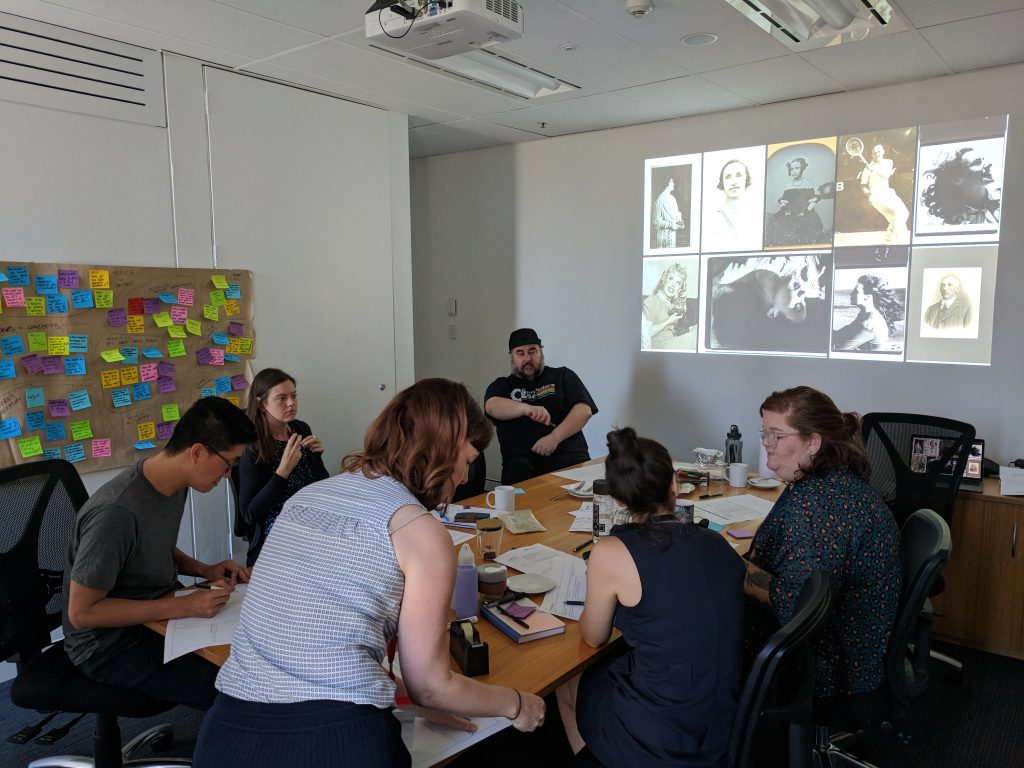
This led us into the discussions on how we might:
- Identify opportunities for the exhibition space that responded to the visitor research
- Address opportunities and challenges for visitors engaging with the Library
- Identify vision and establish design principles
- Define the visitor journey
- Explore all possibilities then refine and test
- Test projections
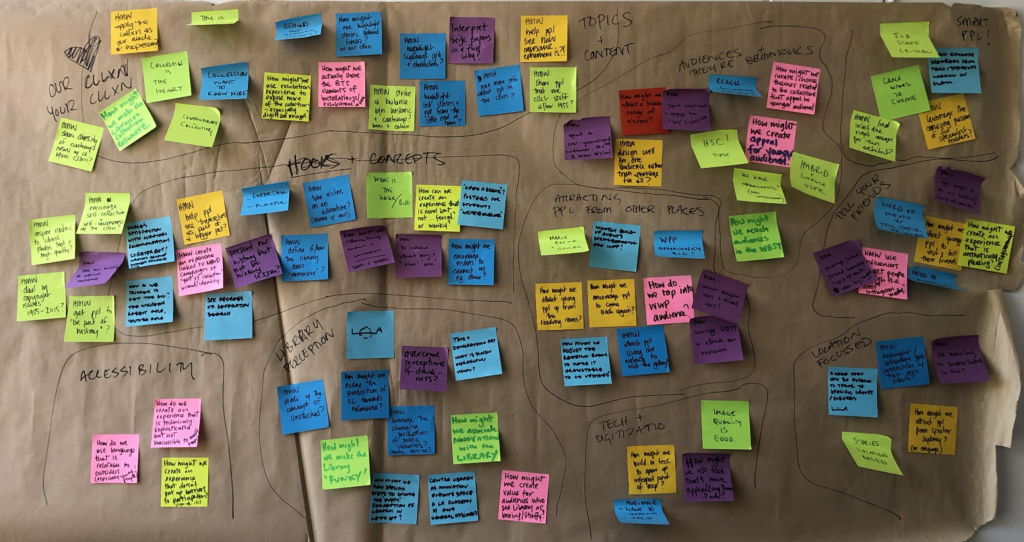
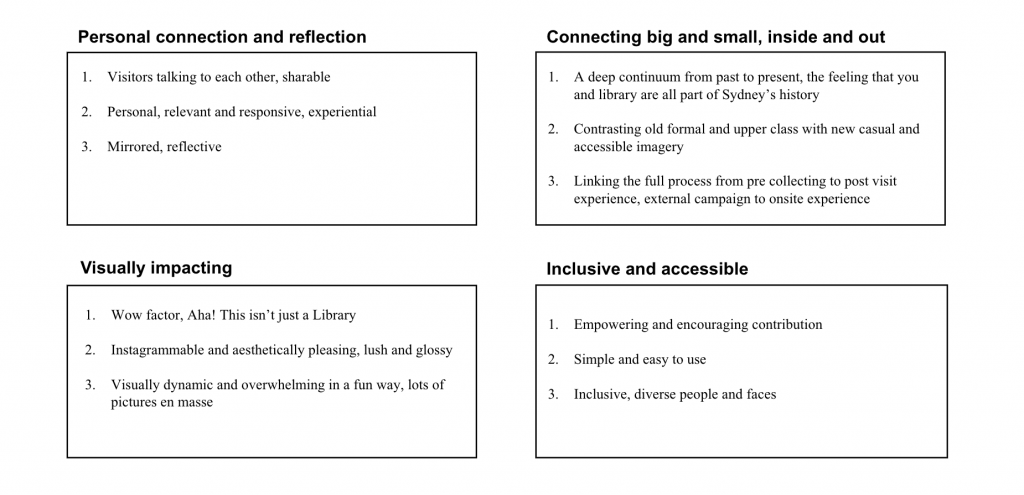

Here are a few of the concepts that have shaped what we have decided to do.
After this workshop we tested some of the ideas with readers in the Governor Marie Bashir Reading room. We wanted to know what brought them to the Library today, how long did they plan on staying, how often do they come, what sort of gallery experiences do they have outside of the Library, did they know about our collection and our galleries and did they go to the galleries. We enquired if they use social media and if so what platforms, what do they normally post, do they use hashtags and do they take portraits of themselves, particularly when visiting an exhibition.
We tested concepts with this group that included a photo booth, large scale immersive projections, about being part of our collection, an infinity room feeling to the space, how important is location awareness, is it important to connect with other visitors and how do they feel about the title #newselfwales?
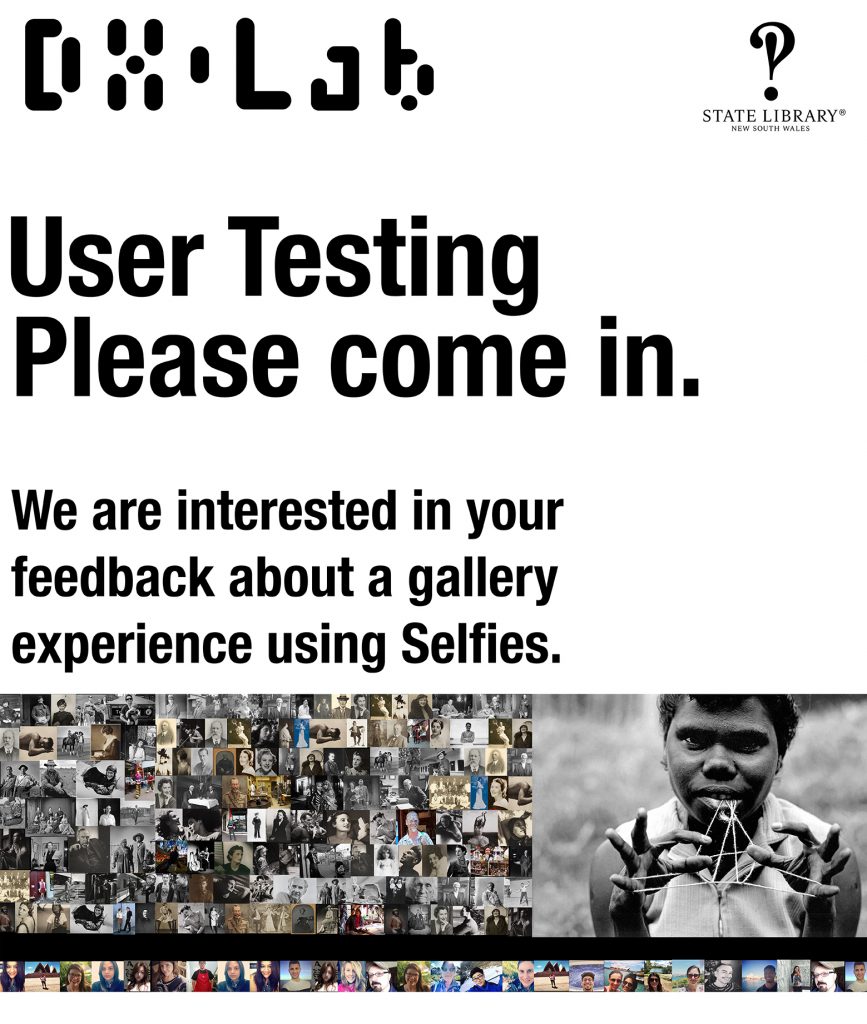
In-gallery test projections
Once we had interviewed readers in our reading room we took some test projection content and projected various interactions on the gallery wall. This cemented design options for us seeing the content at the almost 1:1 scale. The images that are uploaded via Instagram need to be dynamically moved into and mixed into the collection items. The projection needs to be treated like a data feed and not be static. Visitors need to be able to dive deeper into the collection items via a separate touchscreen interface if they want.
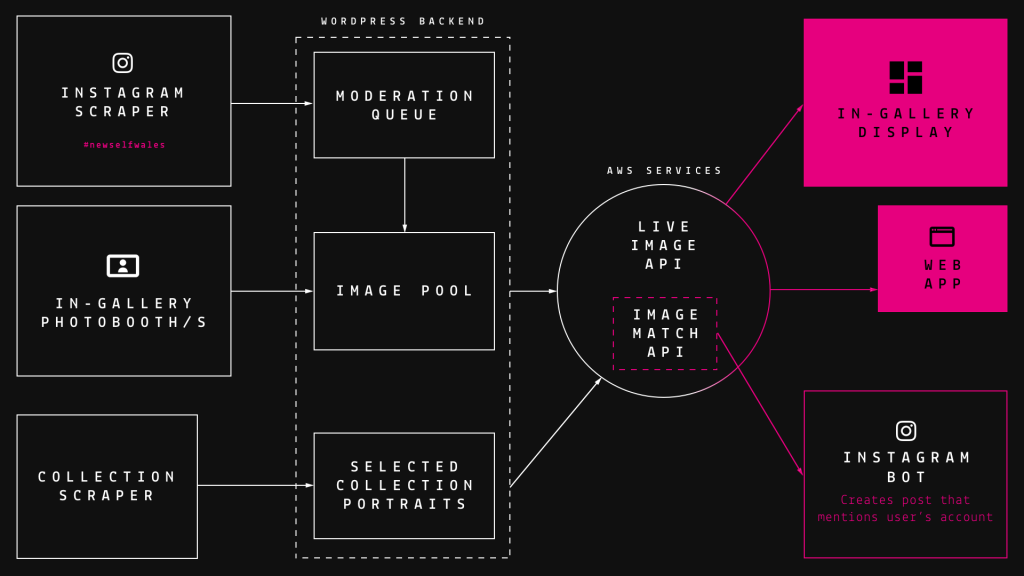
DX Lab Portrait Platform (There will be a blog post on the technology side of this later)
3D Design
One of the decisions that we made from our user research is that we need to provide opportunities for people that do not use Instagram to upload their portrait whilst in the gallery space. Our Exhibition Designer Paul Bewley had to design not only the photo booth space but also the handset for the camera and arcade button that we really wanted as part of the fun of taking a portrait.
The curved walls reflect the shape of the gallery’s barrelled ceiling, helping to divide the exhibition space in an unobtrusive and accessible way. Finished in a mirror-chrome effect metal, the walls reflect their surroundings, helping to merge into the background and putting the focus on the digital projections and exhibition content. Wide openings suitable for wheelchairs, with low-mounted touchscreen kiosks with movable block seating, allows all of our visitors to interact with this. – Paul Bewley, Exhibition Designer.



What did we learn from our readers?
Our readers think that while selfies have become a bit socially unacceptable being included into the collection is a really good thing and our point of difference. They said they would contribute their portrait mainly for this reason. They responded to the collection images we showed and wanted the contemporary images uploaded to social media to have the same kind of context in the setting and not just be a face with no background in the image. They all want a space that they can have some respite from their study and the galleries should provide this for them. We need to make it clear for them on what is going on in the galleries. They felt the Library is being proactive through the collecting of this content and that it was a surprise to them that the Library would collect this material, it felt authentic to them and contemporary. Nearly all of the participants said it is important to show the diversity in the collection and that they want the ability to be able to find out more about each person in the Library’s collection.
Our readers would like to spend time in this space and we need to provide the appropriate seating and atmosphere for them to do this. They have been visiting other galleries and speak highly of immersive experiences that involve the public in thoughtful ways. They were referencing other exhibitions such as Melbourne’s NGV Triennial and the MCA’s Pippilotti Rist Sip My Ocean exhibition and remarked on how much they enjoyed the immersive qualities of both shows. We defined the hook as ‘what does the face of NSW look like in 2018’ so that we can collect this as a moment in time, for history.
We are aiming to reach an audience that does not necessarily go to or know about our galleries and get readers up from the reading room into the gallery space. We will use the social media platform Instagram and the hashtag #NewSelfWales to collect the portraits.
We have invited Dr Kylie Budge, Senior Research Fellow, Urban Living & Society Research Theme at Western Sydney University to work with us on this experience. Kylie has been researching the impact that social media, particularly Instagram has had on the Gallery, Library, Archive and Museum sector. She will work with her research collaborator, Dr Lachlan MacDowall from the University of Melbourne.
I am interested in how user-generated content, like the visually-oriented posts created by library users on Instagram, can tell us something about how people engage with the Library. In the #newselfwales project, the Library is asking a very important question: what does the face of NSW look like 2018? Using visual data, like Instagram posts, is a powerful way to explore this question. As posts are generated by members of the public engaging with the Library, more and more images will be associated with the hashtag, creating a rich visual pool for us to explore, identify patterns and themes, interpret, and draw conclusions that help us respond to the research question.
This project is innovative because it asks people to incorporate themselves into the project via a ‘selfie’ which will then become part of the Library’s collection. In terms of a project that captures a point in time and contributes to digital memory, having these images as part of the collection will be important for generations of people in NSW in the future. They will be able to access and learn from who were are right now. This project deals with the idea of identity. Who are the people of NSW today? How do we see and understand ourselves? How does this connect with the Library’s collection? All of these ideas will come together visually in the new gallery dedicated to this project. I hope as many people as possible participate to ensure the diversity of NSW has a strong visual representation.
– Kylie Budge
The experience will be live from October the 6th.


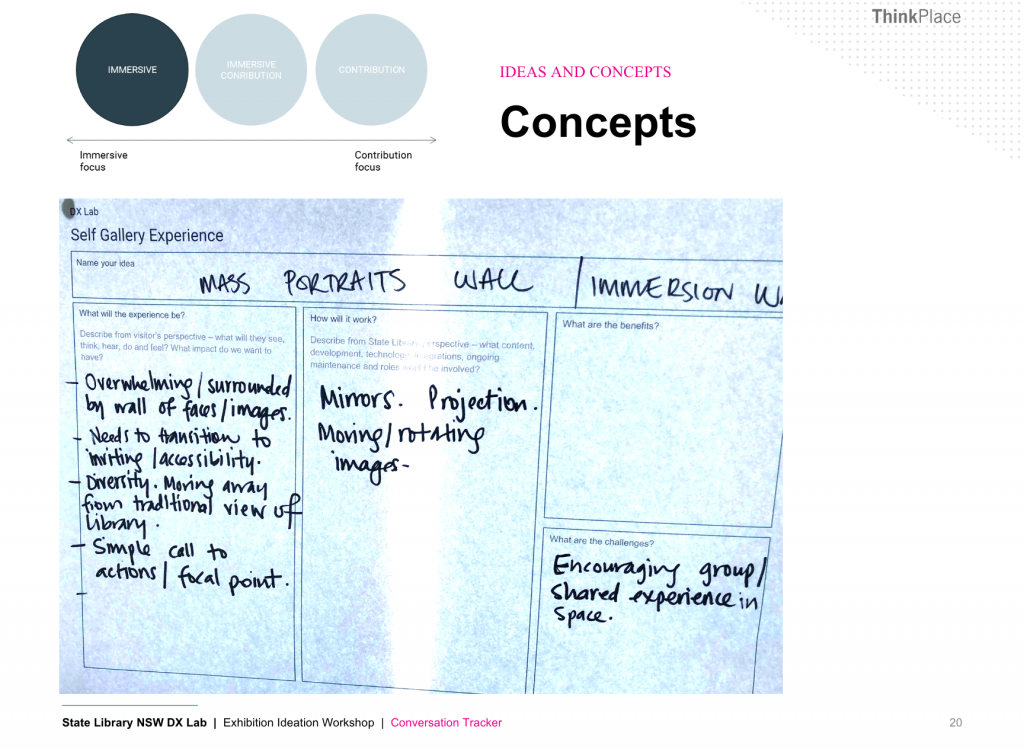
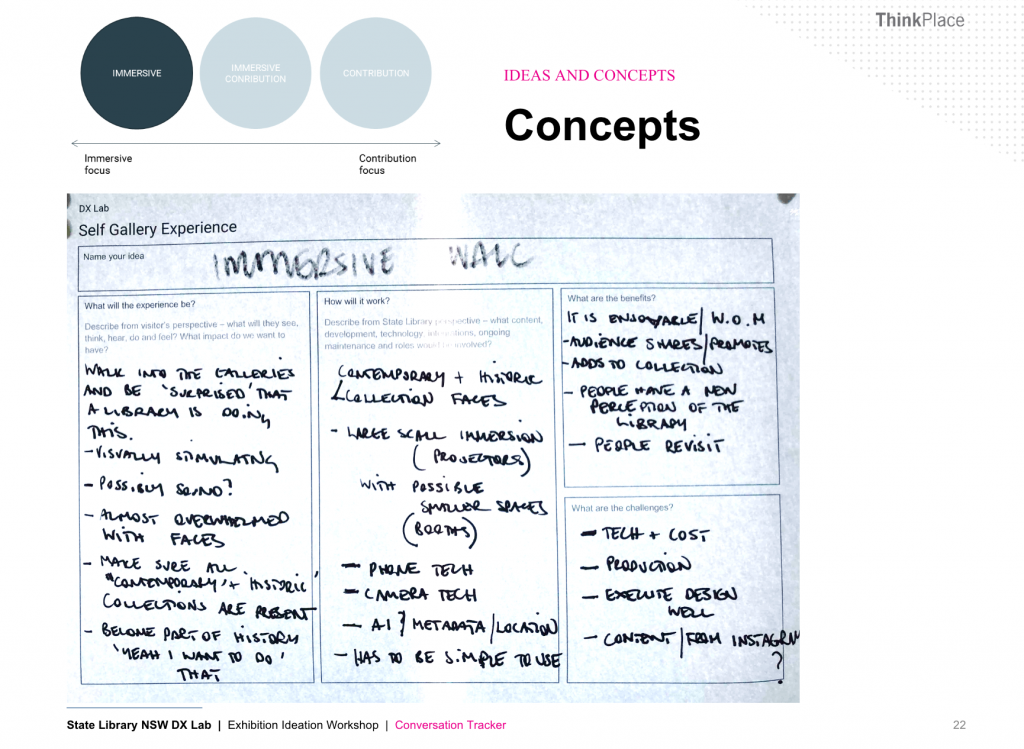
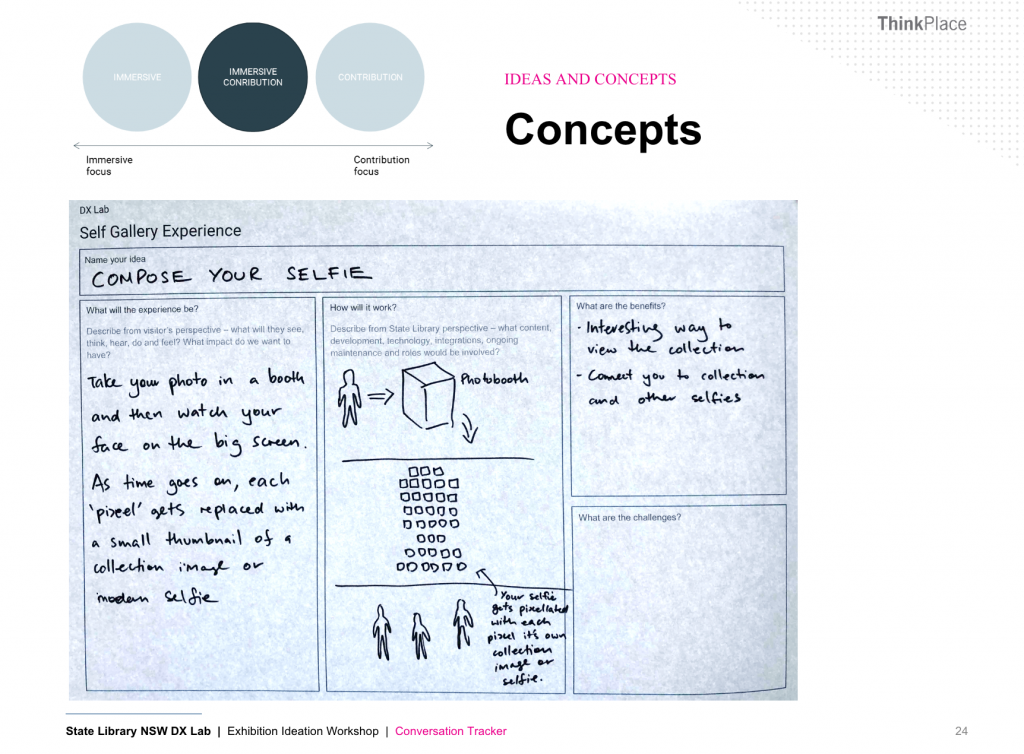

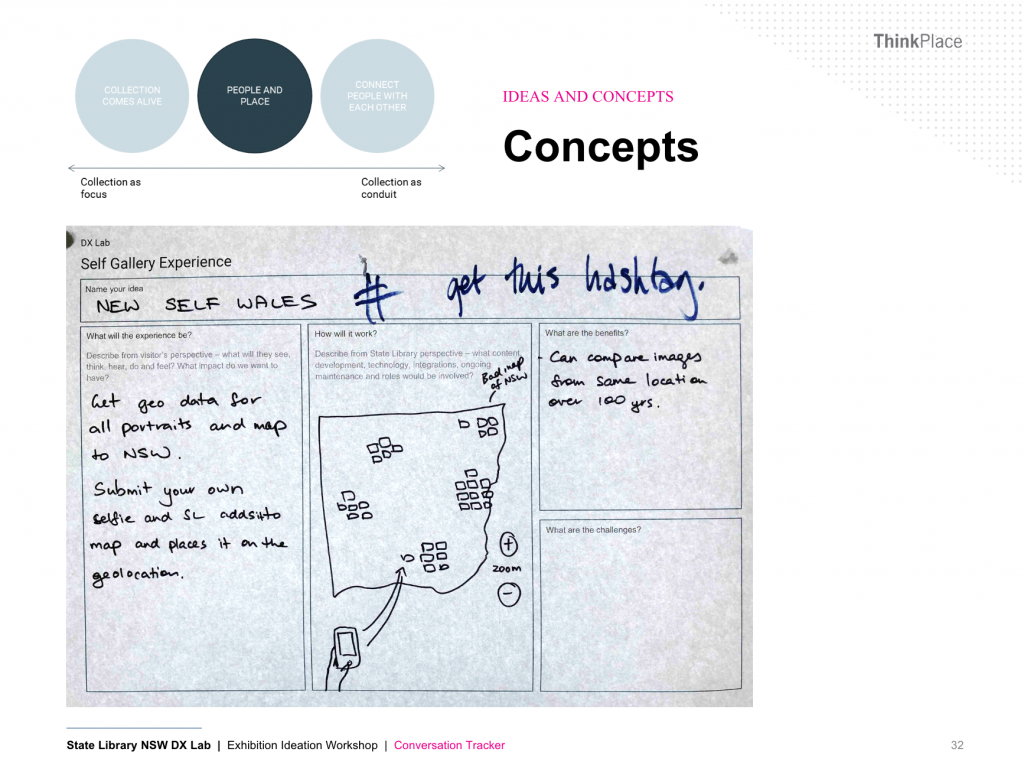

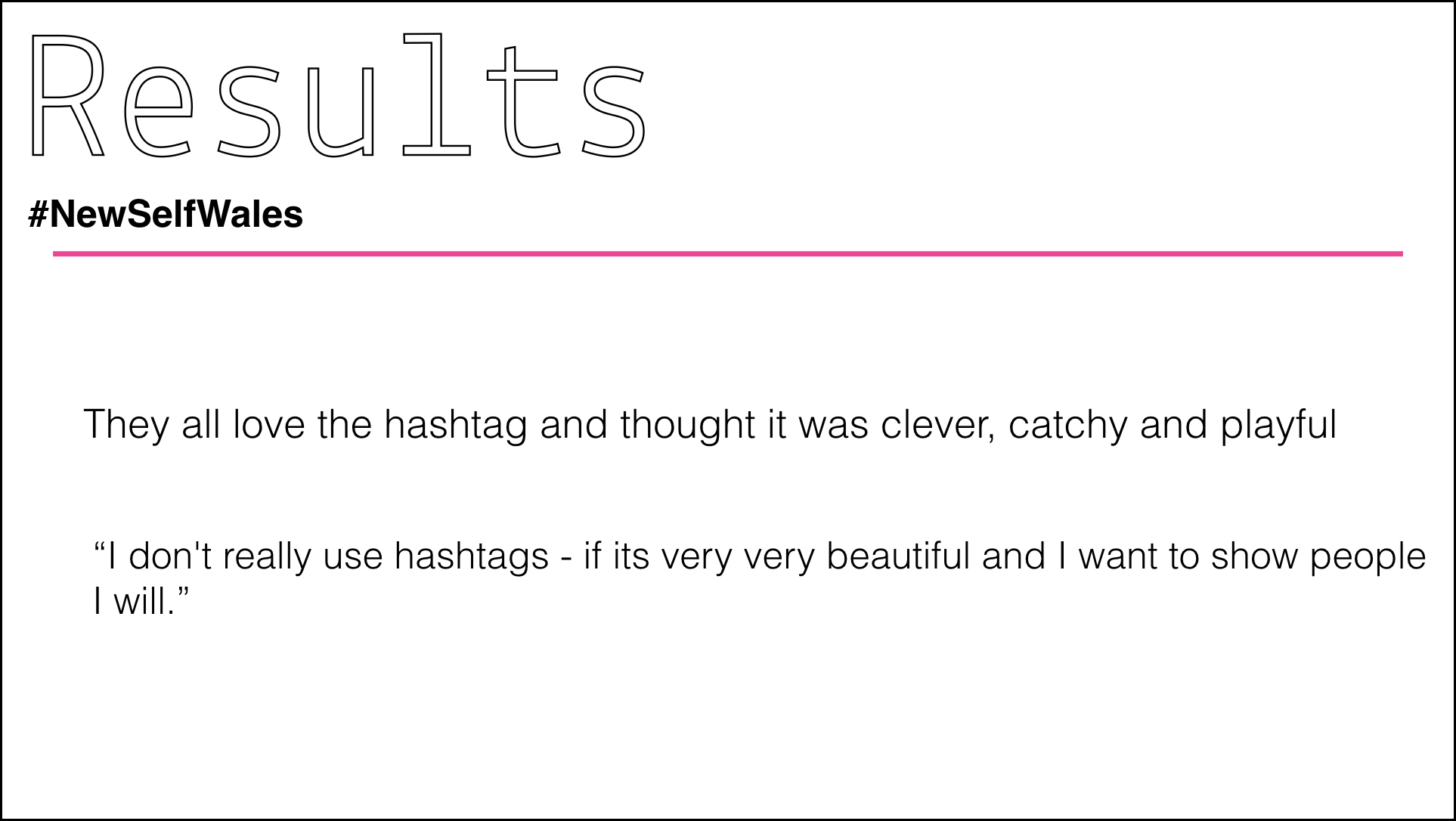
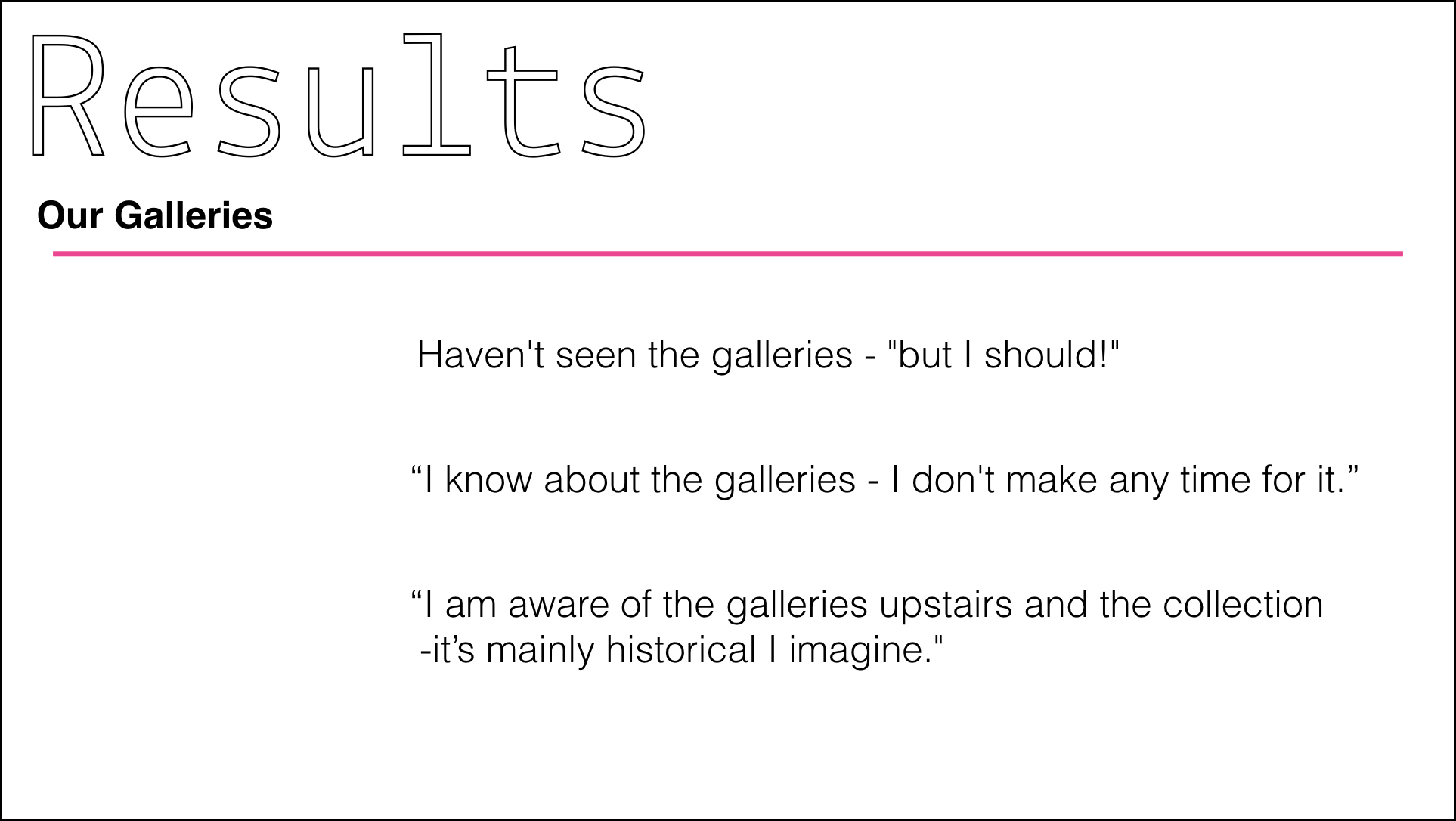

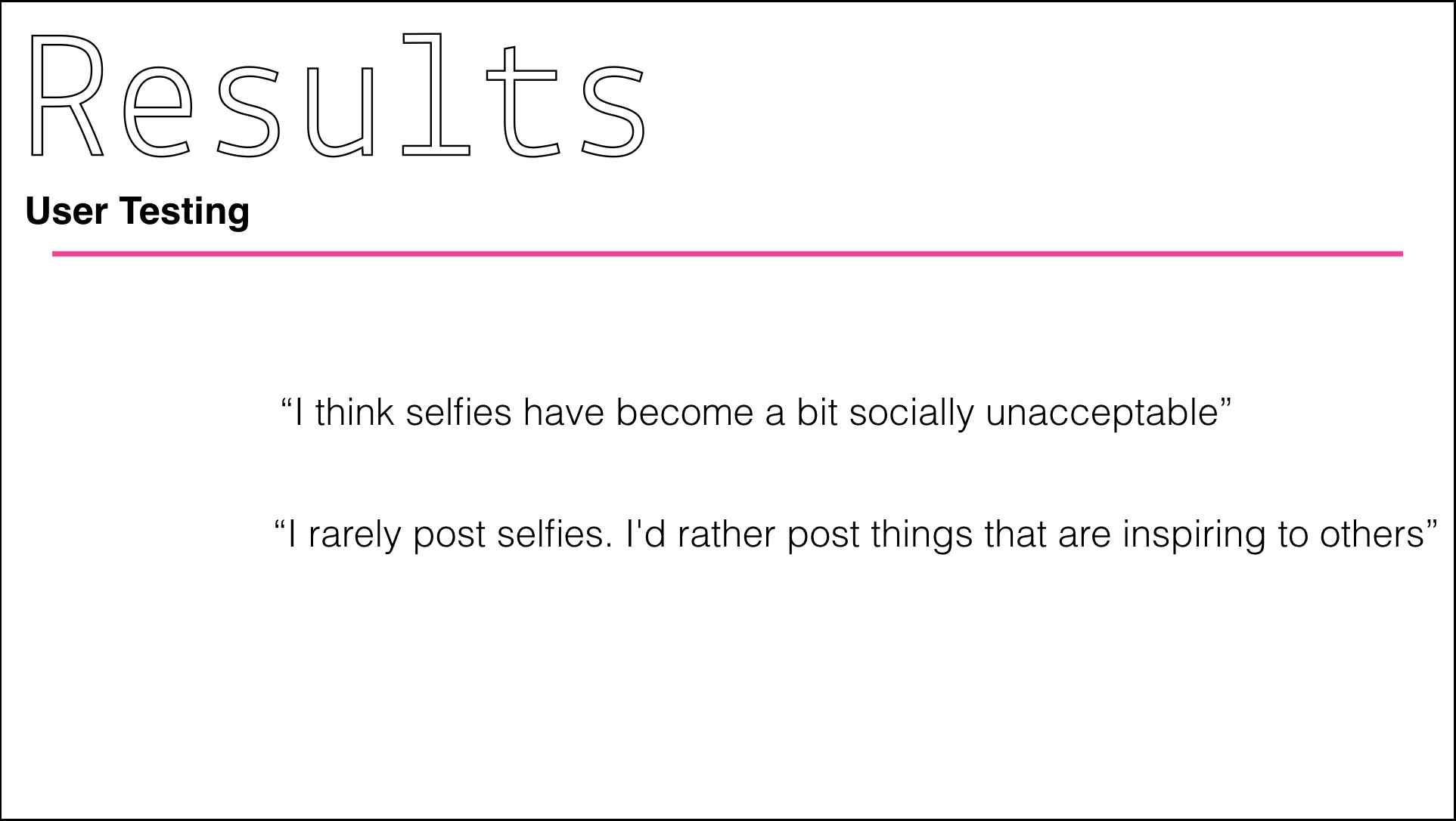

Comments
Great process team – and what a line up!
Look forward to seeing the results in Oct!
Thanks so much for sharing! It is super interesting to learn about how you are using design thinking – and to see you refer to even the result as an experiment.